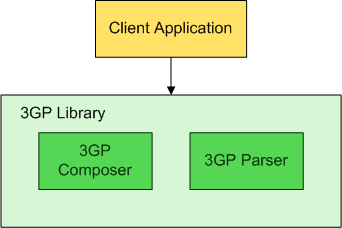3GP Library Overview
This document describes 3GP Library.
Purpose
3GP Library lets you read (parse) and write (compose) 3GP, 3G2, and MP4 files. You can use 3GP Library to provide direct data access for applications. When you need to develop reference audio and video controllers, you can use 3GP Library.
3GP Library details
The DLL that provides the functionality and the library to which your code must link is identified below.
Architectural relationship
The following diagram shows the architecture of 3GP Library:
Description
3GP Library provides two APIs to compose and parse multimedia files.
3GP Composer
The 3GP Composer accepts H.263, MPEG-4 and AVC (also known as H.264) video formats, and AMR, MPEG-4 AAC and QCELP audio formats. These formats are used to create 3GP, 3G2 or MP4 files. If QCELP audio is supplied, the file to be composed is automatically switched to a 3G2 file. To compose an MP4 file, the video source must be either of type MPEG-4 video or AVC, and the audio source must be of type MPEG-4 AAC audio, otherwise the output file type will be automatically changed to 3GP.
3GP Parser
The 3GP Parser parses 3GP, 3G2 and MP4 content containing H.263, MPEG-4 or AVC video formats, and AMR, MPEG-4 or QCELP audio formats. Content can be from a file, a Content Access Framework (CAF) object, or given through memory buffer.
Key 3GP Library classes
The key classes that make up 3GP Library are as follows:
-
This class provides the functions for the 3GP Composer.
-
This class provides the functions for the 3GP Parser.
-
An interface provided by 3GP Library for the asynchronous retrieval of video and audio frames. The client application normally implements M3GPParseCallback.
Using 3GP Library
You can use the 3GP Composer to do the following:
You can use the 3GP Parser to do the following:
See also
Copyright ©2010 Nokia Corporation and/or its subsidiary(-ies).
All rights
reserved. Unless otherwise stated, these materials are provided under the terms of the Eclipse Public License
v1.0.
